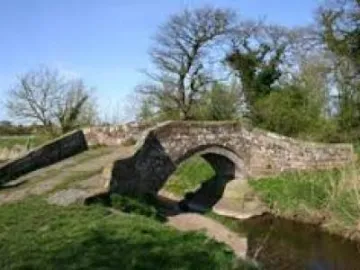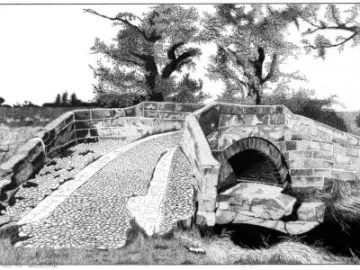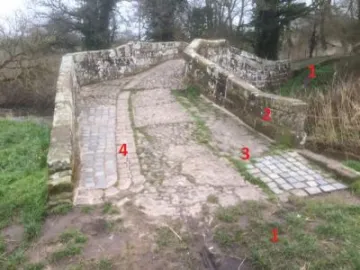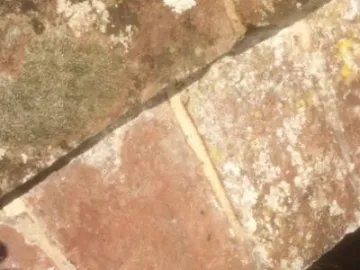Bridge detective 3: The Middle and West bridges

The middle bridge is the most recognisable and most picturesque viewpoint over the Platts, as captured in this splendid drawing by P.Bottomley.
The bridge's greater size, the wide, flared wings ensures it outshines its companions. Unlike them, it shows a good deal of repair work and was subject to a major intervention by 1945. To prevent flood debris blocking and undermining the bridge, the river bed was lowered as part of the straightening of the Gowy in the 1940's. Straightening and embanking the river reduced the flood risk but increased the force of the river.
Most of the repairs were general maintenance but others due to vandalism, with stone blocks removed or dumped in the river, cobbles lifted and graffiti in various forms. However, there are many carved names, shapes and dates, though hard to see, showing the passage of people over many, many years; historical graffiti !
Here are some of the bridge features:
1: The causeway continues towards the west bridge. Unlike the raised one, it is mostly below the surface with only one line of stone blocks marking its path. Indeed, the turn in the bridge alignment after the arch, suggests it was to connect with this earlier causeway.
If a causeway was there long before any form of bridge, then a ford may have existed. Fords invariably preceded a bridge, as at Stamford and Stapleford. It is possible the causeway was so often breached by floodwaters as to require three bridges but the Gowy's story must wait.
2. The parapets are of three courses varying in height on both sides of the pathway or deck. Usually, packhorse bridges had a low kerbstone edge not parapets; the low block on the right could be such a kerbstone.
3&4 Surface repairs such as the mixing of paving indicate the wear-and-tear over the years. The 'cart' setts are lost on this side but remain on the opposite one. The whole central pathway is a hotpotch of cobbles, setts and cement of recent times. Other points of interest: Some shapes, possibly masons' marks, are under the bridge arches. Often showing different masons' and different quarries.
Other points of interest: Some shapes, possibly masons' marks, are under the bridge arches. Often showing different masons' and different quarries.
Fresh sandstone in the arch face is recent and may have been weakened when the river bed was dug out. Also, the sandstone of the bridge appears to be of two types. One, comprising most of the structure is weathered 'plain' stone with a pebbly one in the lower sections.
Recent sandstone is the arch against the original. Below. The pebbly variety, possibly from Tarvin or Barrow.
 In common with the middle bridge it has so-called 'waiting places' as seen in the flared wings of the parapet.
In common with the middle bridge it has so-called 'waiting places' as seen in the flared wings of the parapet.
Here, there are no signs of structural damage possibly because the Gowy did not flow long beneath it. Supposedly, Italian prisoners of war diverted the river here in the 1940's during work on the middle bridge, however, the river was already flowing there before 1805 until 1945
Shared with the middle bridge are so-called 'passing places' as seen in the flared wings of the parapet. Why does the Hockenhull bridge not have this feature when they are same size and design? Were the other two built a long time after it?
Today, this bridge is the watery gateway to the Cheshire Wildlife Trust reserve. A recently cut, a sluiced channel from the Gowy, feeds the small marsh where wildlife, including otters, have a protected home.
Next time: Causeway: Part 1
Quick Links
Get In Touch
TarvinOnline is powered by our active community.
Please send us your news and views.




